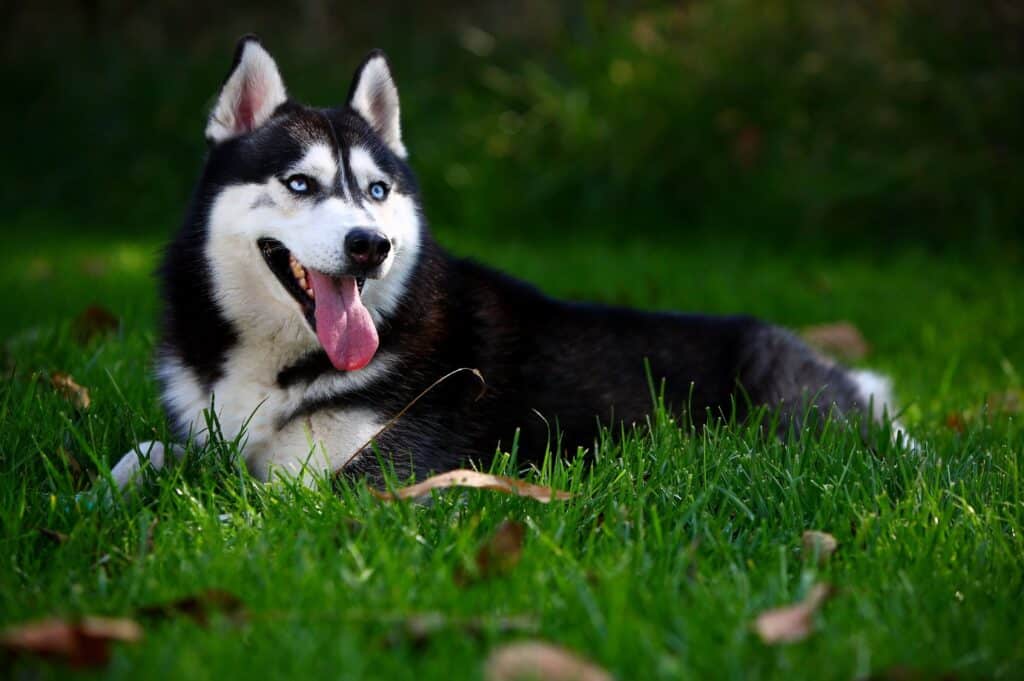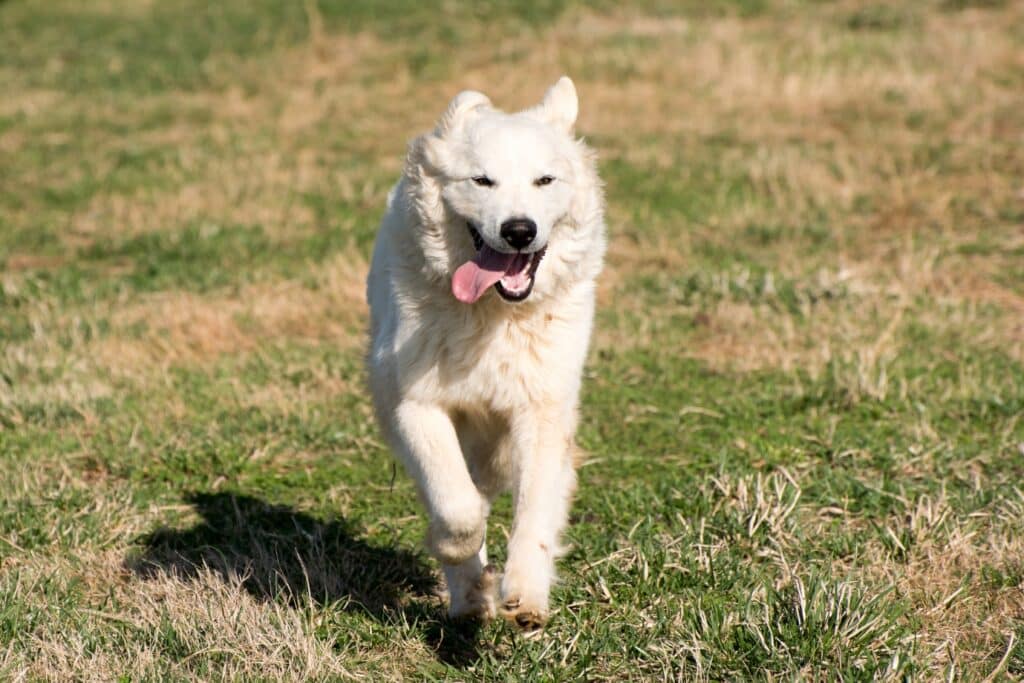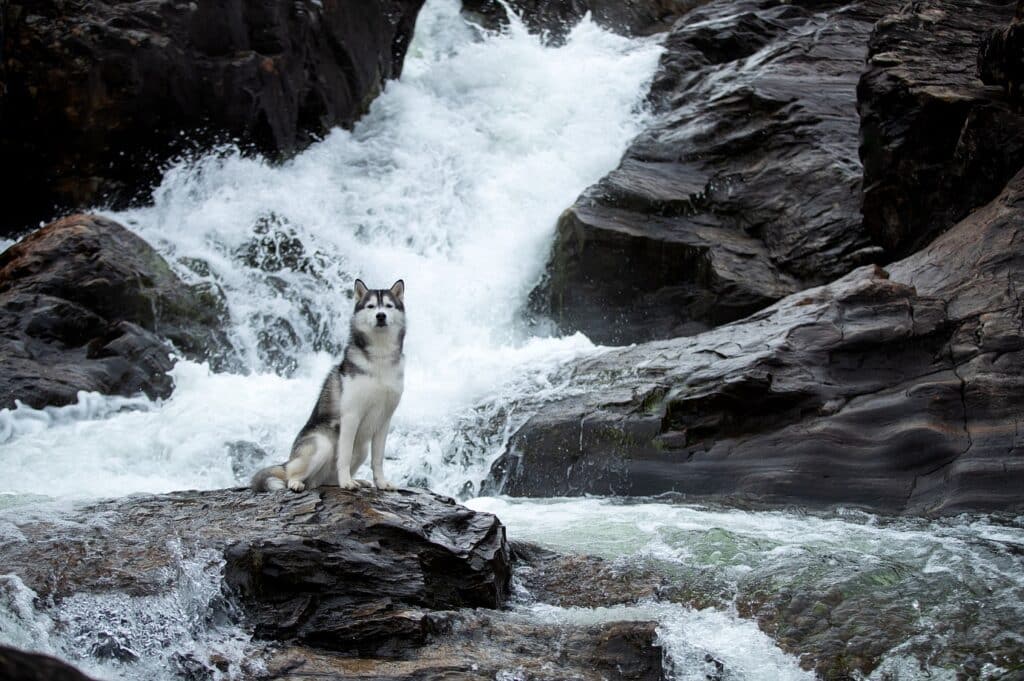Do you love the majestic beauty of the Great Pyrenees but long for the playful nature of the Husky? If so, then you may be wondering if there is such a thing as a Pyrenees Husky mix. Believe it or not, this hybrid dog is becoming more and more popular!
In this blog post, we will discuss 19 key facts about the Pyrenees Husky. We will cover everything from their temperament, health, regular exercise needs, and more!
So, whether you are considering getting a Pyrenees Husky mix or are just curious about them, read on!
The Great Pyrenees Husky Mix Breed – Breeding
The Great Pyrenees Husky mix is a hybrid of the Great Pyrenees and the Siberian Husky. These two parent breeds were originally bred for different purposes – the Great Pyrenees was used as a guard dog, while the Siberian Husky was used as a sled dog.
They share many similarities, however, including their thick coats, independent streak, and love of the outdoors.
This mix combines the best of both breeds, resulting in a dog that is loyal, intelligent, and athletic.
Pyrenees Husky – Appearance
The Pyrenees Husky is a mix between the Great Pyrenees and the Siberian Husky. As a result, they inherit characteristics from both breeds. This mixed breed is a large dog, typically weighing between 75 and 100 lbs.
They have a thick coat of fur that can be either white or gray in color. The coat is dense and waterproof, making the Pyrenees Husky well-suited for cold climates. They have a strong, muscular build and expressive eyes.
Pyrenees Huskies are known for being friendly and good-natured, as well as intelligent and easy to train.
Overall, the Pyrenees Husky is a beautiful dog with a versatile appearance that makes them well-suited for a variety of purposes.
Pyrenees Husky – Coat & Colors
The Pyrenees Husky is a large, powerfully built dog that is known for its thick coat of fur. The most common coat color for this breed is white, but they can also be found in shades of cream, brown, and black.
The Pyrenees Husky’s coat is double-layered, with a dense undercoat and a longer, coarser outercoat. This combination helps to protect the dog from cold weather and keeps them comfortable in both hot and cold climates.
What is their Temperament like?

These dogs are known for being friendly and good-natured, as well as very intelligent. They are also fiercely loyal to their family and make excellent guard dogs.
However, their high intelligence means that they can also be stubborn and independent, which may make training them more difficult than other breeds.
But with patience and consistency, most Pyrenees Huskies will eventually learn basic obedience commands. Overall, the Pyrenees Husky is a friendly, loving breed that makes a great addition to any family.
Pyrenees Husky Mix Breed – Training Needs
Great Pyrenees Huskies make wonderful pets. However, before you adopt one of these beautiful animals, it’s important to understand their training needs.
Like all huskies, Great Pyrenees Huskies are extremely intelligent and easily bored. As a result, they require a lot of mental stimulation. Daily walks are essential, and interactive toys such as Kongs and puzzle feeders can help to keep their minds active.
In addition, Great Pyrenees Huskies need to be taught basic obedience commands such as sit, stay, and come.
Without proper training, these dogs can be very stubborn and difficult to handle. However, with patience and consistent training, Great Pyrenees Huskies can be gentle, loving companions. Remember to start early with basic training like crate training.
Pyrenees Husky – Are they Aggressive?
The Great Pyrenees Husky mix, also known as the Pyrenees Husky, is a cross between the Great Pyrenees and the Siberian Husky. Like their parent breeds, they are large, active dogs that have lots of energy.
However, they are not as aggressive as some people think. In fact, they are usually very friendly and good with children. With proper training and socialization, they can make excellent family pets.
However, they do require a lot of exercise and consistent training so they may not be the best choice for city dwellers.
Pyrenees Husky – Exercise Needs

This mixed breed is a large, active dog that needs plenty of exercise to stay happy and healthy.
A daily walk or run is essential, and this breed also enjoys outdoor activities like hiking, swimming, and playing fetch. If you have an active lifestyle, let your dog join you when you’re moving around.
“Keep in mind that the Pyrenees Husky is an escape artist, so it’s important to have a secure fence or enclosure if you’re leaving your dog outdoors.”
This mix is also known for being very independent, so training may be a challenge.
However, with patience and consistency, most Pyrenees Huskies will learn basic obedience commands.
Overall, the Great Pyrenees Husky mix is a high-energy dog that requires an active owner who can provide plenty of daily exercise and stimulation.
Pyrenees Husky – Mental Stimulation
The Great Pyrenees Husky mix is an intelligent, active breed that requires plenty of mental stimulation.
Like all dogs, they need a certain amount of exercise to stay healthy and fit, but they also need to be mentally challenged in order to prevent boredom and destructive behavior.
A number of simple activities can help to keep your dog’s mind active and engaged, such as obedience training, learning tricks, playing fetch, leash training, agility training, and going for walks in new places.
By providing your dog with mental stimulation, you can help them lead a happy and fulfilled life.
Pyrenees Husky – Grooming
The Pyrenees Husky is a cross between the Great Pyrenees and the Siberian Husky. As a result, they inherit the best of both breeds – the thick, double coat of the Pyrenees and the bright blue eyes of the Husky.
But with this comes a lot of extra grooming even though they are not necessarily heavy shedders. The double coat means that the Pyrenees Husky sheds year-round and will need to be brushed at least twice a week to prevent mats and tangles.
They also have a tendency to drool, so regular teeth brushing is a must. In addition, their thick coats make them susceptible to heatstroke, so they should only be exercised in cooler weather.
With proper care, however, the Pyrenees Husky is a loyal and loving companion.
Pyrenees Husky – Health Conditions
While there is no guarantee that a Pyrenees Husky mix breed will inherit any particular health condition from either parent, certain health problems have been known to occur in this breed.
For instance, the Great Pyrenees are susceptible to hip and elbow dysplasia while the Siberian Husky can suffer from eye problems such as progressive retinal atrophy.
In addition, both breeds are prone to certain types of cancer.
As a result, it is important to be aware of these potential health concerns if you are considering adopting a Pyrenees Husky. With proper care and regular vet check-ups, however, most Pyrenees Huskies enjoy long and healthy lives.
Pyrenees Husky – Nutrition
As with all dogs, nutrition is important for the Pyrenees Husky. A diet that is high in protein and fat will help to maintain the dog’s energy levels, and a diet that is rich in fiber will help to keep the coat healthy and shed hair to a minimum.
It is also important to make sure that the dog has access to clean, fresh water at all times. By providing a nutritious diet and plenty of water, you can help your Pyrenees Husky stay healthy and happy.
Pyrenees Husky – Dog Friendly?

The Pyrenees Husky is a friendly and affectionate breed, but they can also be very independent. As a result, they may not do well in a home with other pets.
However, with proper socialization and training, most Pyrenees Huskies will get along fine with other dogs and animals. If you’re considering adopting a Pyrenees Husky, be sure to introduce them to other pets in the home before making the decision to do so.
Pyrenees Husky – Child Friendly?
Parents looking for a child-friendly dog may want to consider a Pyrenees Husky. These dogs are large and fluffy, with a gentle demeanor that makes them great around kids.
They are also very loyal and protective, which can give peace of mind to parents who want their children to be safe when they’re playing outside. Pyrenees Huskies are relatively easy to train, and they love to exercise, so they make great pets for families who are active.
Although they can be a bit more challenging to potty train than some other breeds, their overall good nature and affinity for kids make them worth the extra effort.
Pyrenees Husky – Drooling Levels
One quirk of the Great Pyrenees Husky mix is their drooling levels. Due to their long jowls and loose lips, they tend to produce a lot of saliva.
This can be a nuisance for owners, especially when the dog is shaking its head or panting heavily. However, it is important to keep in mind that this is simply a trait of the breed and is not indicative of poor health.
Pyrenees Husky – Barking Levels
While they are not known for being particularly vocal, they may bark when they sense something is wrong or when they want to alert their owner to something. In general, however, Pyrenees Huskies are relatively quiet dogs.
If you are looking for a dog that will bark at every little noise, this is not the breed for you. However, if you are looking for a loving and loyal companion, the Pyrenees Husky mix may be the perfect dog for you.
Pyrenees Husky – Adaptability to Weather

As any dog owner knows, all breeds of dogs have different tolerance levels to changes in weather conditions. Some dogs enjoy romping in the snow, while others prefer to stay indoors when the temperature drops.
The Great Pyrenees Husky mix is a large, sturdy breed that is well-suited for colder climates. The thick double coat helps to insulate the body and protect against the elements, and the furry tail provides additional warmth.
In addition, the Pyrenees Husky has a natural affinity for cold weather and is known for being an excellent sled dog. However, it is important to remember that this breed still needs proper care and exercise in order to stay healthy and happy.
Life Expectancy
Due to their size, Pyrenees Huskies often have shorter lifespans than smaller breeds of dogs. On average, they live between 10 and 15 years.
However, with proper care and nutrition, some Pyrenees Huskies have been known to live up to 15 years or more. Therefore, potential owners should be prepared for the commitment of owning a large breed dog.
AKC Recognition
While not yet recognized by the American Kennel Club (AKC), the Pyrenean Husky is a popular choice for those looking for a large, fluffy dog with a friendly disposition.
Therefore, if you are interested in showing your dog in AKC competitions, you may want to consider a Great Pyrenees.
However, if you are simply looking for a loyal and loving companion, the Pyrenees Husky mix makes an excellent choice.
Puppy Prices
If you are interested in purchasing a Pyrenees Husky puppy, be prepared to pay a bit more than you would for other breeds. On average, Pyrenees Husky puppies cost between $1000 and $2500.
However, prices may vary depending on the breeder and the dog’s specific characteristics. For example, some Pyrenees Huskies may have blue eyes, which can increase the price of the puppy.
In addition, some breeders charge more for puppies that have a particularly fluffy coat or are considered show quality. However, regardless of the price, a Pyrenees Husky puppy is sure to bring joy and companionship into your home.
You may also like – Great Pyrenees Golden Retriever Mix (Golden Pyrenees)
Final Thoughts
The Great Pyrenees Husky mix is a large, friendly dog that makes an excellent companion. With proper care and nutrition, they can live to be over a decade old.
They are well-suited for colder climates and love to play in the snow. If you are looking for a loyal and loving companion, the Pyrenees Husky mix may be the perfect dog for you.
Don’t miss – The Ultimate Great Pyrenees Guide – All Questions Answered!


